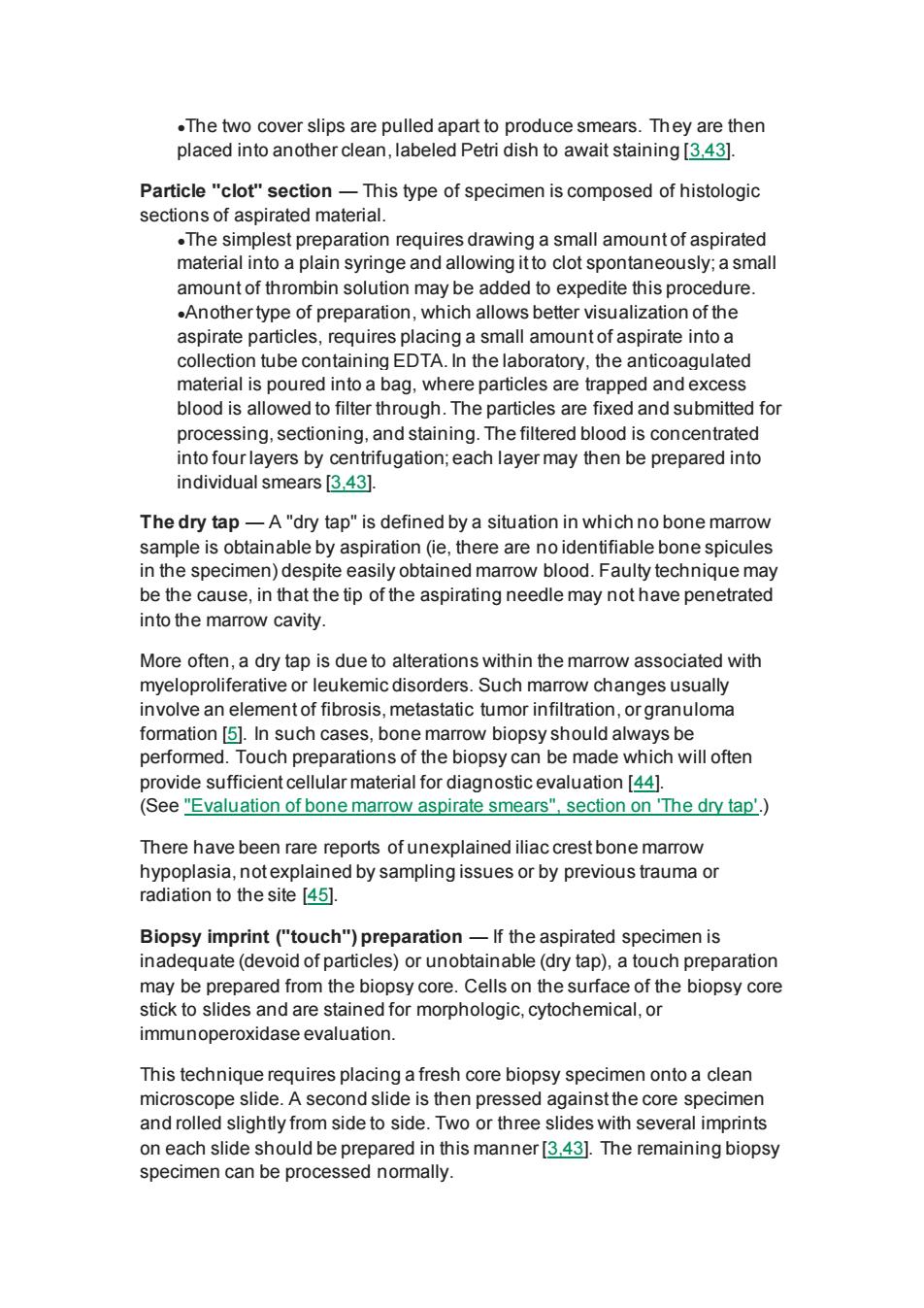正在加载图片...

.The two cover slips are pulled apart to produce smears.They are then placed into another clean,labeled Petri dish to await staining [343]. Particle"clot"section-This type of specimen is composed of histologic sections of aspirated material. .The s es draw a small amount of aspirated material into a plain syringe and allowing itto clot sponta neously;a sma amount of thrombin solution may be added to expedite this procedure. .Another type of preparation,which allows better visualization of the aspirate particles,requires placing a small amount of aspirate into a ion tube c containing EDTA In the labo the agulated mate ag,where particle s are trapped an blood is allowed to filter through.The particles are fixed and submitted for processing,sectioning,and staining.The filtered blood is concentrated into four layers by centrifugation:each layer may then be prepared into individual smears [3,43]. The dry tap-A"dry tap"is defined by a situation in which no bone marrow sample is obtainable by aspiration (ie.there are no identifiable bone spicules in the specimen)despite easily obtained mamow blood.Faulty technique may be the cause,in that the tip of the aspirating needle may not have penetrated into the marrow cavity. More often,a dry tap is due to alterations s within the ma rrow associated with myeloproliferative or leukemic disorders.Such marrow changes usually involve an element of fibrosis.metastatic tumor infiltration,or granuloma formation [5.In such cases.bone marrow biopsy should always be performed.Touch preparations of the biopsy can be made which will often ovide sufficient cellular material for diag ostic evaluation44l】 "Evaluation of bone marrow aspirate smears"section on'The dry tap' There have been rare reports of unexplained iliac crest bone marrow d by sampling issues or by previous trauma or Biopsy imprint("touch")p reparation 一If the aspirated s inadequate(devoid of particles)or unobtainable(dry tap),a touch preparatior may be prepared from the biopsy core.Cells on the surface of the biopsy core stick to slides and are stained for morphologic.cytochemical.or immunoperoxidase evaluation. This technique requires placing a fresh core biopsy specimen onto a clean microscope slide.A second slide is then pressed against the core specimen and rolled slightly from side to side.Two or three slides with several imprints on each slide should be prepared in this manner [343].The remaining biopsy specimen car be processed normally ●The two cover slips are pulled apart to produce smears. They are then placed into another clean, labeled Petri dish to await staining [3,43]. Particle "clot" section — This type of specimen is composed of histologic sections of aspirated material. ●The simplest preparation requires drawing a small amount of aspirated material into a plain syringe and allowing it to clot spontaneously; a small amount of thrombin solution may be added to expedite this procedure. ●Another type of preparation, which allows better visualization of the aspirate particles, requires placing a small amount of aspirate into a collection tube containing EDTA. In the laboratory, the anticoagulated material is poured into a bag, where particles are trapped and excess blood is allowed to filter through. The particles are fixed and submitted for processing, sectioning, and staining. The filtered blood is concentrated into four layers by centrifugation; each layer may then be prepared into individual smears [3,43]. The dry tap — A "dry tap" is defined by a situation in which no bone marrow sample is obtainable by aspiration (ie, there are no identifiable bone spicules in the specimen) despite easily obtained marrow blood. Faulty technique may be the cause, in that the tip of the aspirating needle may not have penetrated into the marrow cavity. More often, a dry tap is due to alterations within the marrow associated with myeloproliferative or leukemic disorders. Such marrow changes usually involve an element of fibrosis, metastatic tumor infiltration, or granuloma formation [5]. In such cases, bone marrow biopsy should always be performed. Touch preparations of the biopsy can be made which will often provide sufficient cellular material for diagnostic evaluation [44]. (See "Evaluation of bone marrow aspirate smears", section on 'The dry tap'.) There have been rare reports of unexplained iliac crest bone marrow hypoplasia, not explained by sampling issues or by previous trauma or radiation to the site [45]. Biopsy imprint ("touch") preparation — If the aspirated specimen is inadequate (devoid of particles) or unobtainable (dry tap), a touch preparation may be prepared from the biopsy core. Cells on the surface of the biopsy core stick to slides and are stained for morphologic, cytochemical, or immunoperoxidase evaluation. This technique requires placing a fresh core biopsy specimen onto a clean microscope slide. A second slide is then pressed against the core specimen and rolled slightly from side to side. Two or three slides with several imprints on each slide should be prepared in this manner [3,43]. The remaining biopsy specimen can be processed normally